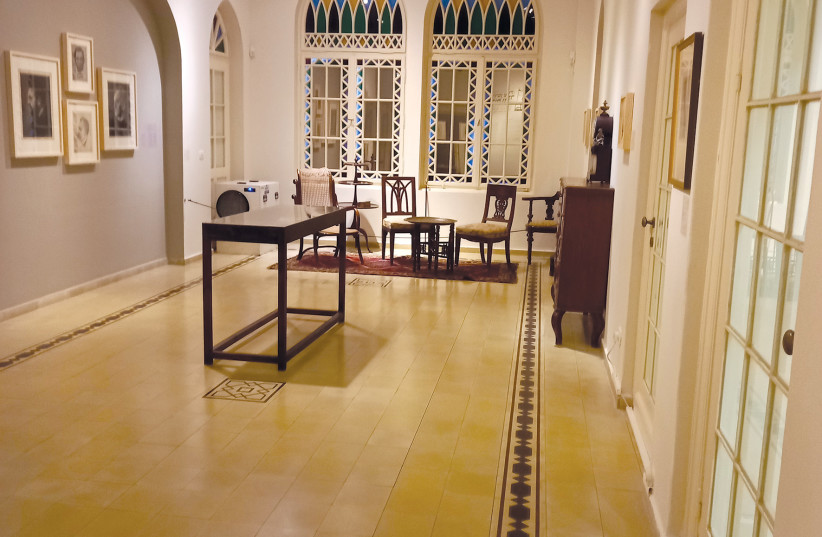Haifa art exhibit shows new life for traditional art techniques

Herman Struck's work portrays rural settings, urban communal space, and houses of worship, showing the impact of human activity on the environment.
It would be easy to walk right past the Hermann Struck Museum, for this beautiful Baerwald house is set in a garden hidden from the busy hilly Arlozorov Street on Haifa`s Hadar. The city`s museums are scattered throughout Haifa, each one specializing in its own genre. The unique ambience of this museum, however, is probably felt because it was the home of this print artist when he arrived in Mandatory Palestine with his wife, Malca, in 1922.
When Hermann Struck died in 1944, his heir (his nephew) donated the house to be used as a museum. It exhibits a collection of 500 works by Struck and his pupils in Israel and abroad, illustrating a spectrum of Struck’s talents in engraving, etching, lithograph, woodblock printing and other techniques. At one time, the museum also exhibited the Musicology and Ethnology collection, but some years ago it was put into storage. This writer searched for links to find out if the exhibits are elsewhere, but the trail ran cold.
I was welcomed to the museum by Dana Nitzani, coordinator of development and management in the main exhibition room, restored with its original features and beautiful windows. Some of the furniture and artifacts that were originally in the home, including Struck`s tallit, are displayed, and the walls are covered with examples of his and others`engravings, portraits and landscapes. The machinery that he used has been maintained. Nitzani explained how engravings are created by covering a brass plate with oil paint, and turning the heavy iron handles that activate the pressure from the roller. Those artists evidently did not need to go to the gym.
The artwork of Hermann Struck
Hermann Struck was born in Berlin in 1876, son of a wealthy merchant and descended from a family of rabbis. He studied Torah and remained a devout Jew throughout his life, never compromising his beliefs even though his work was mainly in the secular art world.
He graduated from the Berlin Academy of Fine Arts. Among his students was Marc Chagall. Struck loved nature, so much of his graphic art was of landscape. But he was also interested in people, so he etched many portraits, ranging from famous personalities such as Nietzche, Freud, Einstein and Herzl to the man in the street. He was part of the Modernist Berlin Movement.

Struck became famous for his print art created on his travels. His work portrays rural settings, urban communal space, and houses of worship, showing the impact of human activity on the environment.
He first visited Eretz Israel in 1903. Inspired by the natural and human landscape, the new Zionist settlement, and the ancient and holy sites, he left with a formidable portfolio of work reminiscent of European Impressionism.
As a patriotic German, Struck volunteered for the Imperial Army in WW I and became head of Jewish affairs in the German section of the Eastern front. He was motivated by Russia`s oppression of its Jews. He documented prisoners of war, a collection of 100 portrait lithographs, identifying various ethnic groups in the East and promoting ethnic German identity. Ironically and tragically, this German cultural dominance led to the adoption of eugenics and scapegoating of the Jews when Hitler came to power.
Struck had always been passionate about the creation of a Jewish state. When he and his wife made aliyah long before Israel`s independence, they chose to live in Haifa for the city’s beauty and potential for artists. He was a founder of the Mizrahi Religious Zionist movement and continued his work, with a large collection of sketches that were exhibited throughout the country. He taught at the Bezalel Academy of Art and helped establish the Tel Aviv Museum of Art.
Nitzani, a graduate in textile art and silk screen from Shenkar College, is now working on her MA. In the upstairs studio, she demonstrated the art of lino prints, of bookbinding and silk screen, using these traditional textile paints and manual pressers.
The original bookbinding press, used today for teaching at the museum, was donated in 2022 by the Huberman family 100 years after the patriarch, Yaakov, established his bookbinding business in Haifa. An activist in the Zionist Workers of Warsaw, he moved to Haifa in 1922 and set up a print and bookbinding business, Kidmain Jaffa Street. It provided work for many families. It was so successful that he brought over his parents and seven siblings, expanding the business for them to run in Haifa and Tel Aviv.
Toward the latter end of the Mandate period, the British police requisitioned the premises, and only in 1948 did he re-open. He passed away soon after and left the business to his son Azrekam. On his retirement, Azrekam wanted to preserve bookbinding as a craft, and the business operated in the Galilee as an active museum.
Now full circle, the iconic press is back in Haifa, where Nitzani and her colleagues at the Struck Museum give courses and workshops on these traditional crafts.
Although there has been progress in digital technologies which has been life-changing for art students, architects and other graphic professionals, this has not made traditional techniques obsolete. Indeed, they have enhanced and expanded the range of options in the print media. ■
Hermann Struck Museum23 Arloszrov Street, HaifaTel: (04) 603-0800info@hms.org.ileducation@hms.org.ilOpening hours: Sunday, Tuesday, Wednesday: 10 a.m. – 4 p.m.Thursday: 10 a.m. – 6 p.m.Closed Monday and Saturday.
